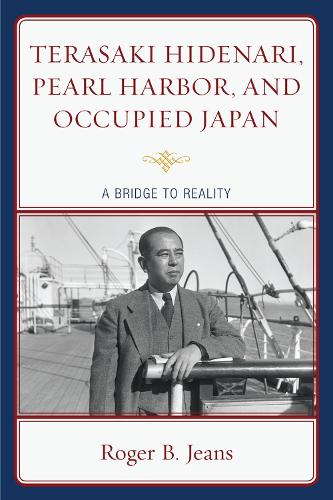
Terasaki Hidenari, Pearl Harbor, and Occupied Japan: A Bridge to Reality
(Paperback)
Publishing Details
Terasaki Hidenari, Pearl Harbor, and Occupied Japan: A Bridge to Reality
By (Author) Roger B. Jeans
Bloomsbury Publishing PLC
Lexington Books
6th May 2011
United States
Classifications
Professional and Scholarly
Non Fiction
Asian history
Second World War
Espionage and secret services
952.03092
Physical Properties
Paperback
298
Width 157mm, Height 233mm, Spine 22mm
463g
Description
Gwen Terasaki's Bridge to the Sun, an idealized memoir of her marriage in the 1930s and 1940s to a Japanese diplomat, Terasaki Hidenari, is still widely read as an inspiring tale of a "bridge" between two cultures that waged savage war against each other from 1941 to 1945. However, neither this memoir nor charges that Terasaki was a master spy and a double agent are the whole historical truth. In Terasaki Hidenari, Pearl Harbor, and Occupied Japan, Roger B. Jeans reassesses Terasaki Hidenari's story, using the FBI's voluminous dossier on Terasaki, decoded Japanese Foreign Ministry cables (MAGIC), and the papers of an isolationist, a pacifist, and an FBI agent and chief investigator at the Tokyo war crimes trial. Jeans reveals that far from being simply a saint or villain, Terasaki, despite his opposition to an American-Japanese war, served as a Foreign Ministry intelligence officer, propaganda chief, and liaison with American isolationists and pacifists in 1941, while using all means to protect Hirohito during the postwar occupation.
Reviews
Terasaki's career has largely been remembered today because of the writings of his widow, who wrote a hagiographic biography, Bridge to the Sun, which became a bestseller and a Hollywood movie. In a masterful biography based on numerous archival sources including the Magic transcripts, Roger Jeans provides a far more nuanced picture, revealing that Terasaki was actually head of Japanese intelligence and propaganda in the Washington Embassy and considered Japan's key spy in the Western Hemisphere by the U.S. government. This study is a must read for those interested in the diplomatic events leading up to Pearl Harbor as well as those interested in the American occupation of Japan. It provides new perspectives on the decision to exempt Emperor Hirohito from the war crimes tribunal and the writing of his monologue on his war responsibility. -- Parks M. Coble, University of Nebraska
By extensive archival research, Roger Jeans gives us a much more nuanced view of Terasaki Hidenari, a complex and important figure both before and after the Pacific War. After the Japanese surrender, the multi-lingual Terasaki became an important link between the Emperor, who feared war criminal charges, and the American occupation. Jeans tells Terasaki's personal story in the context of broader historical forces, including the postwar mythical uses of his career and marriage as a 'bridge' between Japan and America. The book is an important contribution to our understanding of this turbulent wartime era. -- Richard Rice, University of Tennessee Chattanooga
This book offers a thoroughly researched and carefully crafted biography of a now almost forgotten Japanese diplomat who played important roles in U.S.-Japanese relations both immediately before and immediately after the war. U.S.-educated and married to an American, Terasaki was at home both in Japan and the United States and was committed to maintaining a peaceful relationship between the two countries. But, at the same time, he was suspected both by U.S. and Japanese authorities, who believed that a person's loyalty should be just to one nation. This book offers a splendid opportunity to ponder questions of transnationalism as the reader follows the fascinating story of a man who developed trans-Pacific friendships at extremely trying times. -- Akira Iriye, Charles Warren Research Professor of American History, Harvard University
This brief but well-organized study features meticulous research and will be of interest to students and scholars interested in modern Japan. Recommended. * Choice Reviews *
A carefully researched, extraordinarily detailed account of what Terasaki did during the last eleven pre-Pearl Harbor months and the first three years of America's postwar occupation of Japan. * The Journal Of Military History *
Roger Jeans has written a fascinating account of Terasaki Hidenari, diplomat, patriot, husband, spy. Jeans superb historical detective work uncovers numerous misperceptions about Terasaki and reconciles the contradictions of a complex personality caught between two worlds. This even-handed account is a sobering reminder of the pitfalls of using the past to advance contemporary agendas. -- Edward J. Drea, author of Japan's Imperial Army
This is a comprehensive and readable account of Terasaki's life. * The Journal of Japanese Studies *
Footnoted in detail, this is an informative study....This is a straightforward, jargon-free biography aimed at teasing out the details of a complex life in challenging times. Accessible to undergraduates and the general public it illuminates both the road to Pearl Harbour and the road to Japans postwar system. * Pacific Affairs *
Was the Japanese diplomat Terasaki Hidenari a master spy and double agent, or was he a saintly peacemaker who desperately attempted to avert war between Japan and the United States Roger B. Jeans sets out to challenge both of these simplistic views and, instead of recycling cliches and stereotypes, ventures back to the available sources to painstakingly reconstruct a more complex and comprehensive image of the man who acted as a bridge between two nations, Japan and the United States, during two national crises: the outbreak of the Asia Pacific War and the Allied Occupation of
Japan.
Author Bio
Roger B. Jeans is Elizabeth Lewis Otey Professor of History Emeritus at Washington and Lee University.
